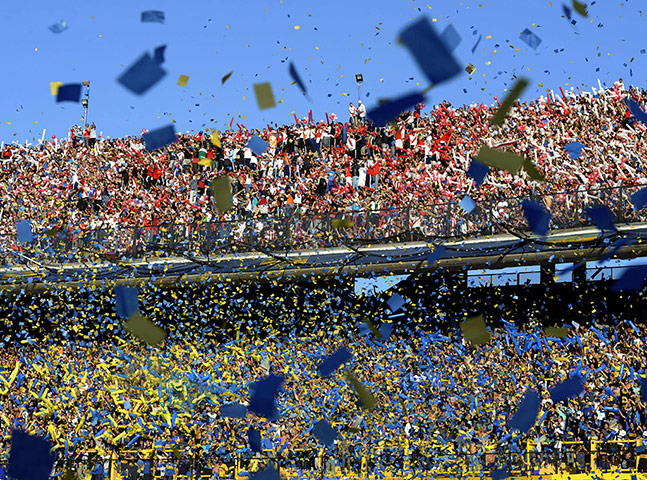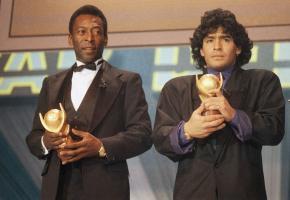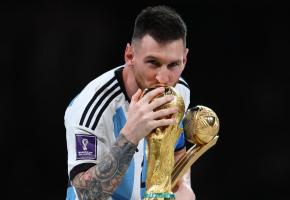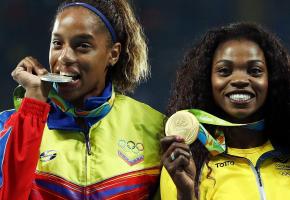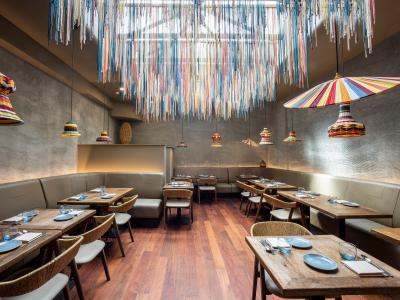1. Superclásico - Boca Juniors vs. River Plate
It’s arguably the biggest rivalry in world football, and certainly the most famous of the South American derbies - el Superclásico is what Argentine football fans live and breathe for. The city of Buenos Aires stands still when the time comes for local rivals Boca Juniors and River Plate to face off. The streets empty, while the population fill bars and homes, huddled around radios and televisions to see who will triumph between the two bitter enemies.
Like most sporting rivalries, the tension between the two clubs derives from the fact that both teams share a city, and divide the population. The animosity is enhanced however by due to the origins of the two clubs. Both Boca Juniors and River Plate began as football clubs in the La Boca neighbourhood of Buenos Aires. In 1925, River Plate moved to Nuñez – a far more middle-class district of the city. The rivalry developed after a class-divide emerged, with River Plate gaining the nickname ‘millionarios’ (millionaires), and responding by referring to Boca as ‘chanchitos’ (little pigs) because of the smell of the slums in La Boca.
Over time, the rivalry has escalated from playful repartee, to tragedy. In 1968, 71 fans were killed and another 150 injured after a crush in the Puerta 12 section of the River Plate stadium. Reports vary as to where the blame lies, and after a three year government enquiry, nobody could be found guilty.
The rivalry is by its very nature extremely tense, which can often lead to violence in and around the stadia. Despite this, the fixture has become a pilgrimage spot for avid football fans who seek to sample the atmosphere of the great derby. As it stands today, Boca Juniors lead the head-to-head records with 116 wins compared to River Plate’s 104.
2. Derby Paulista - Corinthians vs. Palmeiras
This rivalry began in 1914, after four members of the Italian community of São Paulo were inspired to start their own club, after a selection of Italian teams toured Brazil. These men wanted to form a team who could become the face of São Paulo, despite the fact that the men in question were already part of Sport Club Corinthians Paulista. That August, Palestra Italia (later renamed Palmeiras) were founded, and so began the Paulista rivalry.
Nicknamed ‘the betrayers’, Palmeiras are bitterly despised by fans of Corinthians; however Palmeiras currently boast the better head-to-head record. It is very close, but Palmeiras have won 121 derbies, while Corinthians are on 119. In 1974 over 120,000 fans watched Palmeiras beat Corinthians in their home stadium, and the fixture is widely accepted as one of the greatest rivalries in world football.
3. Uruguayan Clásico - Club Nacional de Football vs. Club Atlético Peñarol
By far the biggest game in Uruguayan football, the Clásico is contested by Uruguay’s two dominant football clubs. Between them, Nacional and Peñarol have won 90 of the 108 Uruguayan Primera División titles, and their rivalry is one of the oldest footballing rivalries outside of Britain.
Both clubs were founded in the capital city Montevideo, with Peñarol originally made up of British immigrants from the Central Uruguay Railway Company of Montevideo. Nacional on the other hand have traditionally consisted of just native players, and it is from this that the rivalry between the two clubs began. Since their first meeting at the turn of the twentieth century, a number of matches have stuck in the memories of Uruguayan football fans – mostly for comical reasons.
In 1934, during the final of the Copa Uruguaya, a misplaced cross went out of play, only to rebound back onto the pitch off a medical box. From the resulting play, Peñarol scored, only for the goal to be disallowed following tremendous protests from the Nacional players and fans. The game ended up being replayed and Nacional won the title with a 3-2 victory.
The most comic of them all was a fixture in October of 1949, now referred to as ‘el Clásico de la fuga’ (the escape). Peñarol were leading 2-0 when the teams went off for half time. After the 15 minute break, Nacional simply didn’t return, and thus are constantly reminded of the time they ran away from a Clásico. In return, they remind their rivals of December 14, 1941 – ‘el dia de diez’ (the day of ten), when Nacional’s first and second teams won 6-0 and 4-0 against Peñarol, inflicting a humiliating 10-0 accumulative defeat upon their great rivals.
4. El Clásico de Clásicos - América vs. Guadalajara (Chivas)
This rivalry started fairly late in comparison to the others. Despite Club América and Chivas being the two oldest teams in the Mexican league, it was not until the 1958–59 season when América became a direct rival of Chivas in the quest for the Mexican title.
Chivas typically only ever employ Mexican players, while América often sign players from other nations. As a result, Chivas are known as the team with the ‘best Mexicans’ while América are the team of the ‘best foreigners’. Since 1959, the two sides have battled for the top spot in the Liga MX, and their rivalry dominates Mexican sporting culture. It even made it into a famous telenovela called La Rosa de Guadalupe, where in a Romeo and Juliette style drama, the two lovers’ families support the rival teams. Currently, both sides hold 11 titles.
5. El clásico del fútbol chileno - Colo-Colo vs. Universidad de Chile
Probably the most political of all the South American football derbies, this rivalry has divided Chileans since the clubs first met in 1938. Colo-Colo have traditionally been popular among the working class, while Universidad de Chile is identified as a far more middle-class side among Chileans.
The rivalry reportedly began when a punch was thrown by a Colo-Colo player during a tie between the two sides, and since that day, fixtures have become an opportunity for fans to sing all sorts of political chants in the stands throughout the games – mostly due to Augusto Pinochet’s involvement with Colo-Colo.
Iván Zamorano – one of Chile’s most recognised players – maintains that “of all the derbies I've played in my life, Colo Colo-Universidad de Chile is by far the most important." This statement is particularly significant given that Zamorano has featured in matches between bitter rivals Barcelona and Real Madrid, as well as the Milan derby and the El Clásico de Clásicos in Mexico.
6. Peruvian Clásico - Alianza Lima vs. Universitario
The Lima derby is a particularly hostile fixture. The first encounter between the two sides was abandoned after Alianza Lima had five players sent off. Violence ensued both on the pitch and in the stands, with canes thrown onto the pitch. That particular meeting is now commonly referred to as El Clásico de los Bastonazos (canes).
The two sides have met in a number of high-profile fixtures, and many titles have been decided by the outcome of these derbies. Most recently, in 2009 during the Torneo Descentralizado finals, which Universitario won, to end an eight season long title drought, and claim their 25th First Division title.
After a tragic plane crash in 1987, during which the entire Alianza squad and coaching staff lost their lives, Colo-Colo of Chile sent a number of players on loan to Alianza as a friendship gesture. Following this gesture, a number of Alianza fans support Colo-Colo – particularly during the Chilean derby.
7. Clásico del Astillero - Barcelona SC vs. Emelec
Despite both coming from the city of Guayaquil, these two sides did not meet until August 1943. Since then, the tie has become El partido inmortal (the immoral game) for Ecuadorian football fans. Of the many meetings between the two sides, the most high-profile came in 1990 when they faced off in the quarter-finals of the Copa Libertadores. Barcelona triumphed on the day, and progressed to the semi-finals of the competition at the expense of their bitter rivals.
In recent years, the fixture has been tainted by violence and tragedy. In 2006, 30 fans were injured after Barcelona fans began to riot when their team went 3-0 down. The following year, an 11 year old Emelec fan lost his life after being hit by a flare before the start of the game. Actions like these have been heavily condemned by the governing bodies, as a great football rivalry should never under any circumstances escalate to violence and the loss of an innocent life.
A film was made in 1973 titled ‘El derecho de los pobres’ focusing on the rivalry. It starred a number of well known Mexican actors, as well as Alberto Spencer who is widely accepted as the greatest Ecuadorian footballer of all time.
8. Avellaneda Derby - Club Atlético Independiente vs. Racing Club
Another derby that has been tainted by violence in the past; the Avellaneda rivalry began in 1907 when Independiente (initially founded in Monserrat, Buenos Aires) moved across town to Avellaneda where Racing Club were based. Currently, the two sides’ stadiums are only a few hundred meters apart, and as a result the rivalry is particularly fierce.
Commonly regarded as the second biggest Argentine rivalry, the Avellaneda derby matches have often been the cause of much controversy. A match between the two sides in 1961 was suspended by the referee for 6 minutes after the players became involved in a mass brawl on the pitch. Eventually the game continued, however after the 90 minutes were up the referee had brandished eight red cards.
In 2002, a fight broke out between roughly 400 fans in front of Independiente's stadium. A number of police officers were injured, and two fans were shot dead during the conflict. Almost 100 people were arrested on the day, and since then the Argentine football authorities have been particularly strict on the two clubs’ fans. For a period of time Racing Club fans were banned from their home ground in 2006.
9. Fla–Flu – Flamengo vs. Fluminense
In 1911, a group of dissatisfied Fluminense players elected to break away from the club, and founded Clube de Regatas do Flamengo instead. Since that day, the rivalry between the two sides has been immense, and fixtures between the two are held in the most iconic of all the world’s football stadiums – the 78,000-seat Maracanã Stadium.
The two sides often meet in important fixtures. In both 1941 and 1991 the Campeonato Carioca final was disputed between Flamengo and Fluminense. The first was won by Fluminense, and the second won by Flamengo with a 5-3 aggregate win.
In 1995, Fluminense clinched the title on Flamengo’s 100th birthday as a professional club – a success Fluminense fans will never tire of reminding their rivals. Overall, Flamengo have won two more titles than Fluminense (33-31), while the biggest crowd ever attracted by a Fla-Flu fixture was in 1963, when 194,603 fans packed inside the Maracanã to watch a 0-0 draw.
10. Rosario Derby - Newell's Old Boys vs. Rosario Central
Whenever the time comes for a Rosario derby, the city is completely divided. There are simply no neutrals in Rosario. Central boast the support of the iconic Che Guevara, while Newell’s is the boyhood club of 4 time ballon d'or winner Lionel Messi.
Mario Zanabria, who scored a title clinching goal for Newell’s against Central in 1974 knows better than anyone the importance of the tie. “People start to move differently on the sidewalk” he has been quoted as saying... “It moves an entire city.”
The most memorable Rosario Derby to date (for a neutral) came on June 2, 1974, when Newell's won their first ever title by coming from 2-0 down at half time to record the draw they needed to win the Metroploitano.


